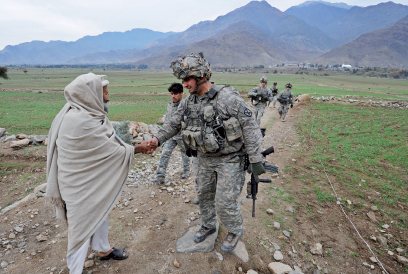Printed Page 365
CONVERGING MEDIA
Case Study

YouTube and Wartime PR
The Vietnam War was also known as the “Television War” because the seemingly unending river of images of American casualties and strategic futility appearing on newscasts played a key role in undermining public support. In 1992, and again in 2003, the U.S. military developed and deployed ways of managing the press, including the use of embedded reporters, to avoid repeating the public relations mistakes of Vietnam and to generate more favorable journalistic coverage of military actions in Iraq and Afghanistan. But these strategies could not contain a new public relations threat on the battlefield—the presence of digital cameras. Just as Twitter has complicated relations between VIPs and their publics, the widespread use of digital cameras, included in so many smartphones and other mobile devices, has had a terrific impact on the waging of war.
The new realities of waging war in the face of converged media was the subject of a 2009 report by Cori E. Dauber that was published by the Strategic Studies Institute of the U.S. Army War College. Titled YouTube War: Fighting in a World of Cameras in Every Cell Phone and Photoshop on Every Computer, the report argues that “Terrorist attacks ought to be understood as consciously crafted media events”: “Their true target is not that which is blown up—that item or those people—for that is merely a stage prop. The goal, after all, is to have a psychological effect (to terrorize), and it isn’t possible to have such an effect on the dead.”1 The report finds that mainstream television journalism often uses footage released by insurgents because of the visual power of the imagery—even though this practice essentially expanded the audience for the enemy propaganda while actually encouraging more attention-getting “newsworthy” actions.
There’s an even more daunting and devastating threat to waging war in a world saturated with digital cameras: Images from the cameras of U.S. service members which, at worst, can become the public-relations equivalent of the damage caused by friendly fire. The most damaging of these incidents involved photographs taken by military police personnel of the U.S. Army documenting torture of prisoners held at the Abu Ghraib prison in Iraq. First reported in 2004 by CBS, the photos were believed to have circulated via e-mail before being seized by military authorities. More recently, in January 2012, a video surfaced on the Internet documenting four U.S. Marines urinating on Taliban corpses in Afghanistan. Prompting a flurry of media stories, the video has complicated U.S. efforts at winning the trust and respect of the population in that war-torn part of the globe.
The U.S. military, then, must contend with the way converged and viral media makes public relations trickier and more difficult to control. Part of fighting a war in an era of global and converged media involves recognizing that public perceptions matter and because of this, images matter—images that are more accessible and easier to disseminate than ever before. Soldiers and military leaders should be made aware of a major consequence of the inevitable spread of these images: Their actions and attitudes undermine their terrorism-fighting mission.